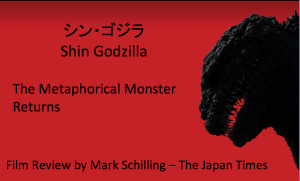Film Review as featured in The Japan Times
Mark Schilling, an author with The Japan Times, writes a film review of the 2016 remake of Godzilla titled ‘Shin Godzilla’. He gives an overview of the plot and shares two ways in which Shin Godzilla serves as a metaphor to Japan’s interaction with the environment. This is through analysing the characteristics and actions of Godzilla itself, and the responses of the people to it. He states that this movie is not a continuation of the long line of Godzilla movies that started in 1954, but is set in modern day Japan suggesting that the ideas that are brought up are representative of our interactions with today’s environment. More than just an action movie, Godzilla has traditionally been portrayed symbolically as a destructive force of nature (Wikizilla) that serves as a ghost that haunts Japan of its past deeds.
Firstly, Schilling focuses on the meaning of Godzilla through its characteristics and actions. In the process of making landfall in Tokyo, Godzilla creates a wave of destruction as it pushes inland and leaves a radioactive trail in its wake. Schilling argues that this is a metaphor for the 3/11 triple disaster in the form of “an ambulatory tsunami, earthquake and nuclear reactor, leaving radioactive contamination in his wake” (Schilling, 2016). This metaphor closely links to Shun’ya’s point that “manmade disasters [are] linked to contemporary science and technology” (Shun’ya, 2012, p. 320) and how Japan has embarked on a path of building nuclear power plants as an “effective way to bring about “liberation” from memories of the atomic bombings” (Shun’ya, 2012, p. 325). Symbolically, Godzilla is the portrayal of how the pursuit of technological progress through the use of nuclear power backfires and in turn, causes widespread damage and more importantly a lingering radioactive environment that will render the area poisoned.
Secondly, as Schilling looks at the interactions of the people in the movie, he uncovers how there is self-sacrifice experienced by them. He notes various groups such as the government officials, Self-Defense Forces Officers, and the anti-Godzilla task force and talks about their self-sacrifice in the face of losing their lives in the immediate danger caused by Godzilla or the radioactive trail it leaves. Schilling establishes the link to the “Fukushima 50”, who had sacrificed themselves by exposing themselves to extreme levels of radiation whilst containing the crippled Fukushima Dai-ichi Nuclear Plant. Walker echoes this idea of self-sacrifice through the relation of pain and the nation, and how it is experienced across Japanese history (Walker, 2010). We see how the movie sends the message on how the ones that suffer the direct consequences of the benefit are the innocent who did not have any direct involvement in the decision making process.
Schilling does well to shed light on its readers that Shin Godzilla is more than just an action movie but serves as a metaphor that encapsulates Japan’s modern interactions with nature and how it backfires in the form of Godzilla’s arrival into Tokyo.
(493 words excluding references)
References
- Schilling, M. (2016, August 3). ‘Shin Godzilla’: The Metaphorical Monster Returns. Retrieved October 12, 2016 from The Japan Times: http://www.japantimes.co.jp/culture/2016/08/03/films/film-reviews/shin-godzilla-metaphorical-monster-returns/#.V_4Zk5N94UE
- Shun’ya, Y. (2012, May). Radioactive Rain and the American Umbrella. The Journal of Asian Studies , 319-331.
- Walker, B. (2010). Toxic Archipelega: A History of Industrial Disease in Japan. Seattle: University of Washington Press.
- (n.d.). Godzilla Misconceptions. Retrieved October 12, 2016 from Wikizilla: http://godzilla.wikia.com/wiki/Godzilla_Misconceptions
